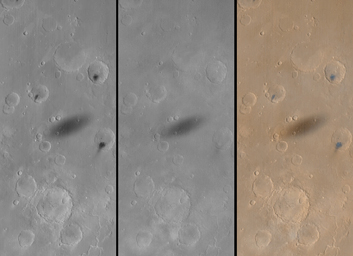|
2002/05/04 Meta Research is not an observatory and has no large telescopes. Moreover, the moons of Mars are too faint to be seen by any but the world’s largest telescopes except when they are close to Earth. And those largest telescopes are fully booked with work that does not include routine checks to make sure that all the solar system’s moons are still in place.
However, when Mars was last close to Earth in June 2001, the moons were within range of some smaller and medium-sized telescopes, and were routinely observed throughout the spring and summer months, at least through the end of July.
See, for
example, this 2001 July 28 image on display
at another web site. The Internet
hoax that the moons had disappeared began well before that image,
and is therefore proved false as far as we are concerned.
Anyone having official need to know about recent photos taken for updates on the orbits of the moons with the 51-inch astrometric reflector of the U.S. Naval Observatory in Flagstaff, AZ could contact the U.S. Naval Observatory in Washington, DC or in Flagstaff and learn how many Mars images showing the moons were taken during the most recent period (in mid-2001) when Mars was close to Earth.
The next opportunity for photos from Earth will occur just after mid-2003.
The Mars Global Surveyor spacecraft in orbit around Mars (and itself a "moon of Mars", albeit an artificial one) last photographed Phobos in 1998, before its mapping mission began. Beginning in early 1999, the MGS spacecraft pointed its camera straight down at Mars and began its official mapping mission.
It was not subsequently allowed to stray from this vertical nadir-pointing until the completion of the multi-year mapping mission. However, during the mapping, the spacecraft did photograph the shadow of Phobos sweeping across Mars on some occasions.
See the inset image below, posted to the MSSS/JPL/NASA official web site on 2002/03/17.
Regrettably, Internet hoaxes are now quite common, and they hurt the credibility of all scientists. They work so well because so many people tend to believe something claimed with “authority” rather than withhold judgment until it can be checked out.
Those who buy into the hoax then become the hoaxer’s unwitting allies, and will fiercely resist information that might show they had been duped.
The result is that these rumors spread all over the world and get far more attention than they should. When I was in college 40 years ago, an informal competition arose periodically among my fellow students, usually around exam time, to see who could fool the most people with a hoax.
Fortunately, they had no Internet to spread the hoax far and wide, so it usually died out quickly with a minimum number of “victims”. Today, we can no longer count how many people are taken in by these incidents.
|

